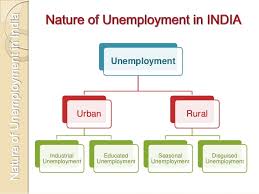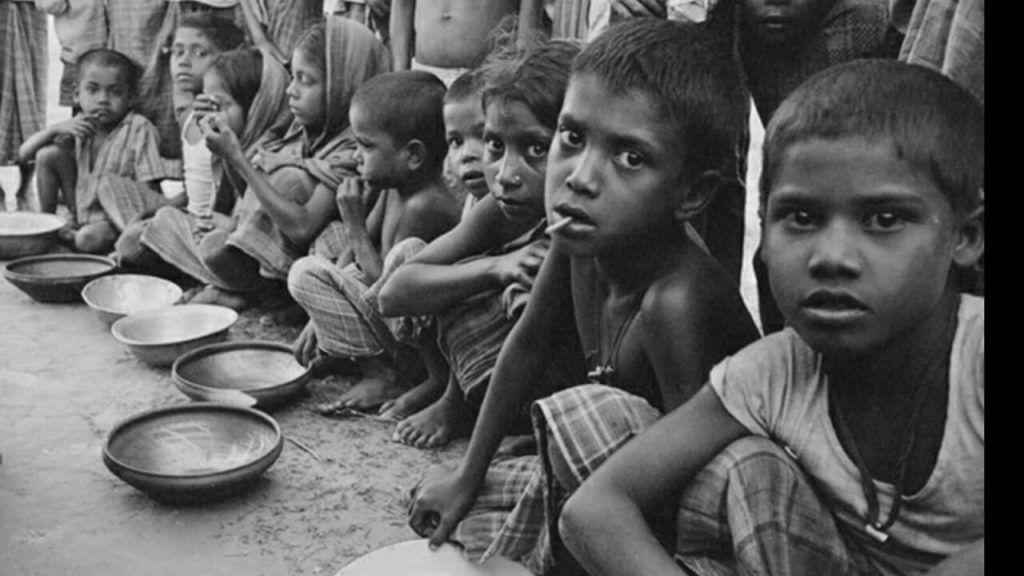The World Bank defines poverty in absolute terms. The bank defines extreme poverty as living on less than US$1.90 per day> (PPP), and moderate poverty as less than $3.10 a day. Types of Poverty Absolute poverty measures poverty in relation to the amount of money necessary to meet basic needs such as food, clothing, and shelter. The concept of absolute poverty is not concerned with broader quality of life issues or with the overall level of inequality in society.
The concept of absolute poverty is based on absolute norms for living (measured in terms of consumption expenditure) laid down according: to specified minimum standard and all such individuals or groups whose consumption expenditure is found to be below this standard are classified as poor. Under the relative concept of poverty, a family (or an individual) is deemed to be poor if its level of income or consumption expenditure falls below a predetermined level.
Poverty in India is measured as the head-count ratio of the population living below the official ‘poverty line’, which is calculated using the methodology prescribed by the Expert Group on Methodology for Estimation of Poverty appointed by the Planning Commission in order to arrive at a threshold consumption level of both food and non-food items. The methodology uses the Consumer Expenditure Surveys (CES) conducted by the National Sample Survey Office (NSSO) of India once every five years to attain the poverty line; and, hence, poverty figures in India are obtained once every five years. The Planning Commission’s latest poverty line, using methodology suggested by the Tendulkar Committee in 2010, is apparently defined as the spending of Rs. 27.20 per capita per day in rural areas and Rs.33.40 per capita per day in urban areas.
Unemployment is a phenomenon that occurs when a person who is actively searching for employment is unable to find work.
Nature, types and Problems of Unemployment in India:-Unemployment may be defined as “a situation in which the person is capable of working both physically and mentally at the existing wage rate, but does not get a job to work”.
India is one of those ill-fated underdeveloped countries which is suffering from a huge unemployment problem. But the unemployment problem in India is not the result of deficiency of effective demand in Keynesian term but a product of shortage of capital equipment’s and other complementary resources accompanied by high rate of growth of population.
Present unemployment problem in India is mostly structural in nature.
Unemployment problem of the country can now be broadly classified into:
(a) Rural unemployment and
(b) Urban unemployment.
(a) Rural Unemployment:
In India the incidence of unemployment is more pronounced in the rural areas.
Rural unemployment is again of two types:
(i) Seasonal unemployment and
(ii) Disguised or perennial unemployment.
(i) Seasonal Unemployment:
Agriculture, though a principal occupation in the rural areas of the country, is seasonal in nature. It cannot provide work to the rural population of the country throughout the year. In the absence of multiple cropping system and subsidiary occupation in the rural areas, a large number of rural population has to sit idle 5 to 7-months in a year.
Seasonal Unemployment is also prevalent in some agro- based industries viz., Tea Industry, Jute Mills, Sugar Mills, Oil Pressing Mills, Paddy Husking Mills etc.
(ii) Disguised or Perennial Unemployment:
Indian agriculture is also suffering from disguised or perennial unemployment due to excessive pressure of population. In disguised unemployment apparently it seems that everyone is employed but in reality sufficient full time work is not available for all.
In India, about 72 per cent of the working population is engaged in agriculture and allied activities. In 1951 more than 100 million persons were engaged in the agricultural and allied activities whereas in 1991 about 160 million persons are found engaged in the same sector resulting in as many as 60 million surplus population who are left with virtually no work in agriculture and allied activities.
(b) Urban Unemployment:
Urban unemployment has two aspects:
(i) Industrial unemployment and
(ii) Educated or middle class unemployment.
(i) Industrial Unemployment:
In the urban areas of the country, industrial unemployment is gradually becoming acute. With the increase in the size of urban population and with the exodus of population in large number from rural to the urban industrial areas to seek employment, industrialization because of slow growth could not provide sufficient employment opportunities to the growing number of urban population.
Thus the rate of growth of employment in the industrial sector could not keep pace with the growth of urban industrial workers leading to a huge industrial unemployment in the country.
(ii) Educated or middle-class Unemployment:
Another distinct type of unemployment which is mostly common in almost all the urban areas of the country is known as educated unemployment. This problem is very much acute among the middle class people. With rapid expansion of general education in the country the number of out-turn of educated people is increasing day by day.
But due to slow growth of technical and vocational educational facilities, a huge number of manpower is unnecessarily diverted towards general education leading to a peculiar educated unemployment problem in the country. The total number of educated unemployment increased from 5.9 lakh in 1962 to 230.50 lakh in 1994.
• Types of Unemployment
The most accepted classification of Unemployment recognizes two broad types: Voluntary and Involuntary Unemployment.
Voluntary unemployment arises when an individual is not under any employment out of his own desire not to work. Could be from their total apprehension towards the concept itself, or it may be that an individual is unable to find work paying his desired wages and he doesn’t want to settle.
Involuntary unemployment encompasses all those factors that prevent a physically fit individual willing to work from getting an appointment. According to John Maynard Keynes, “involuntary unemployment arises due to insufficiency of effective demand which can be solved by stepping up aggregate demand through government intervention”. Involuntary Unemployment is further categorized into subheads;
1. Structural: Such employment stems from any structural change in the economy that leads to decline of specific industries. Long term changes in the market conditions, reorganization of the same, and sudden changes in the technological sector, creates a Skill Gap in the existing workers.
2. Regional: Globalization and relocation of jobs also leads to unemployment as workers are often unable to move to the new location where the employers currently hold positions.
3. Seasonal: In some industries production activities are season best and employment occurs only in peak seasons. Agro-based industries and tourism industries are examples of this form of unemployment.
4. Technological: This type of unemployment is either generated following the introduction of technologically advanced mechanization that renders manual labour redundant, or through inclusion of technology that the current labour force is ill-adapted to.
5. Frictional: This type of unemployment happens when the labour is either transitioning between jobs or is trying to find a job more suited to their skill set. Friction is generally referred to the time, energy and cost that a person invests while searching for a new job.
6. Educated: This form of unemployment happens when people with advanced degrees are unable to procure an engagement that is suited to their level of training.
7. Casual: Some occupations can only offer temporary employment to individuals and their engagements are subject to termination as soon as the demand subsides. Daily labourers who work on a day-to-day basis are example of such types of unemployment.
8. Cyclical: This type of unemployment refers to the periodic cycle of unemployment associated with cyclical trends of growth in business. Unemployment is low when business cycles are at their peak and high when the gross economic output is low. Several external factors like wars, strikes and political disturbances, natural calamities that affect business cycle are also contributors to cyclical unemployment.
9. Disguised: This is a scenario when more people are employed in a job than is actually required for it. This is hallmark of developing economies where availability of labour is abundant. It is primarily a feature of the agricultural and unorganized sectors.
Problems caused due to unemployment
Unemployment and poverty goes side by side. The problem of unemployment gives rise to the problem of poverty.
Young people after a long time of unemployment find the wrong way to earn money.
To get rid from the unemployment stress, they accept alcohol or drugs.
Unemployed youths accepts suicide as the last option of their life
Lower economic growth
Increase rate in Crimes. As the employed youth don’t have anything to do they start doing robbery, murder etc.
Health issues i.e it affects mentally as well as physically
HUMAN POVERTY INDEX (HPI)
The Human Poverty Index (HPI) was first introduced into the Human Development Report by the United Nations Development Programme (UNDP) in 1997 in an attempt to bring together in a composite index the different features of deprivation in the quality of life to arrive at an aggregate judgement on the extent of poverty in a community.
There are two indices; the HPI – 1, which measures poverty in developing countries, and the HPI-2, which measures poverty in OCED developed economies.
Calculation of HPI-1 for Developing countries:-The following three dimensions are taken into account:
- deprivation of longevity, measured as a percentage of the individuals with a life expectancy lower than 40 years (P1).
- deprivation of knowledge, expressed as a percentage of illiterate adults (P2).
- deprivation of decent living standards (P3). This last indicator is made up by the simple average of three basic variables:
- the percentage of the population without access to drinking water (P31),
- the percentage of population without access to health services (P32) and lastly,
- the percentage of underweight children aged less than five (P33).
The indicator P3, referred to the living standard, is then obtained as an average of the three indicators, in this way:
[(P31 + P32 + P33) / 3The global index HPI-1 is obtained by combining these three dimensions into one single measure giving a greater weight to the most disadvantaged situation.
The formula is:
HPI-1 = [(P13 + P23 + P33 ) / 3]1/3
While HPI-2 is calculated as follows:-
MULTI DIMENSIONAL INDIAN POVERTY INDEX
Poverty is a multi-dimensional issue and various experts/committees and institutions estimate poverty based on different perceptions/definitions. However, Planning Commission is the nodal agency in the Government of India to estimate poverty in the country. TheMultidimensional Poverty Index (MPI) was developed in 2010 by the Oxford Poverty & Human Development Initiative (OPHI) and the United Nations Development Programme. and uses different factors to determine poverty beyond income-based lists. It replaced the previous Human Poverty Index.
Various dimentions of MPI are:-
| Dimension | Indicators |
|---|---|
| Health |
|
| Education |
|
| Living Standards |
|
Life expectancy at birth: Number of years a newborn infant could expect to live if prevailing patterns of age-specific mortality rates at the time of birth stay the same throughout the infant’s life.
Expected years of schooling: Number of years of schooling that a child of school entrance age can expect to receive if prevailing patterns of age-specific enrolment rates persist throughout the child’s life.
Mean years of schooling: Average number of years of education received by people ages 25 and older, converted from education attainment levels using official durations of each level.
Gross national income (GNI) per capita: Aggregate income of an economy generated by its production and its ownership of factors of production, less the incomes paid for the use of factors of production owned by the rest of the world, converted to international dollars using PPP rates, divided by midyear population.
- MPPCS Mains 2024 Tests and Notes Program
- MPPCS Prelims Exam 2024- Test Series and Notes Program
- MPPCS Prelims and Mains 2024 Tests Series and Notes Program
- MPPCS Detailed Complete Prelims Notes



